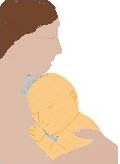
| ||
|
| ||
Infant TouchLearn and use four methods of infant touch that will help the baby grow and thrive. Skin to Skin ContactFirst Moments of Life The value of skin to skin contact has already been mentioned. Not only does it help the just-born baby to adjust to her new extra-uterine life, it also helps her as she grows. This skin to skin contact is the first sequence in the development of the mother baby rhythm. Kangaroo CareFirst Weeks of Life The United States has actually been a late-comer in offering kangaroo care to infants. However, once it was done, it became apparent that this practice is not only valuable for pre-term infants, but also for full-term infants as well (isn't that a surprise.) With Kangaroo Care, the infant is wrapped skin to skin with the mother except for a diaper and a cap. The mother is in an upright position. Fathers also can use the Kangaroo Wrap with their little ones. The difference between skin to skin contact and kangaroo care is largely a matter of timing: skin to skin generally refers to the contact with a just-born baby who has yet to have been bathed or manipulated by others. Kangaroo care usually refers to the return of the baby to the mother who holds the little one skin to skin with nothing between them. Another scenario where the kangaroo wrap may be adopted is when the mother delivers in a hospital that does not allow her to have skin to skin contact at birth. When the baby is returned to her, devoid of his sense of direction and missing the smell of amniotic fluid on his hands which assists him to locate the breast, the kangaroo wrap can be employed. Over the next weeks, skin to skin contact can be initiated between mother and baby at home. Fathers, too, can share in the skin to skin kangaroo wrap with benefit for both of them. Mothers and baby's who have had a difficult start breastfeeding or who were unable to have the skin to skin time in the early days of life, have felt that skin to skin contact in the bathtub was comforting to both and helped them to connect to one another. Baby WearingFirst Months of Life One study found that American babies at one month of age are alone 67.5% of the time, compared to Korean babies that are alone 8.3% of the time. Another study indicated that infants in all known hunting-gathering societies carried their infants more than 50% of the time; while American babies are carried less than 25% of the time. As a result, American babies cry more during a 24 hour period than infants in societies where they are carried. In another study, parents were encouraged to carry their infants more through the day using a carrier that holds the baby next to the parents. The researchers found that the amount of time parents held their baby increased from 2.7 hours per day to 4.4 hours on average, but the amount of crying decreased 43%. Anthropologists who have studied infant behavior have noted that infants in all societies have about the same frequency of crying. That is, they all start to cry about the same number of times per day. However, in those societies where infants are held, their needs are responded to much quicker, and the duration of crying is much shorter. The infant is comforted, so that he or she spends much less of their time - and energy - crying. Many harried mothers who are stressed about leaving their infant at daycare would find much appeal in moving to a hunting-gathering or agricultural community where they could keep their babies with them in a sling all day long. But for quite a few mothers, such a life style is not a feasible option. But even when parents are not able to spend as much time as they would like holding the infant, the practice of infant massage can enhance the bonding between them. Infant MassageFirst Years of Life Infant massage, as well as infant wearing, are practices that have come to us from Third World societies that place high priority on the mother/infant bond. Indeed, not only does the practice of infant massage strengthen the parent/child bond, it also has other benefits as well. Massage has been shown to
Better Childbirth Outcomes HOME PAGE. | ||
| | ||
|
By Karen Newell Copyright 2003 - 2012 Better Childbirth Outcomes - All Rights Reserved
Camp Hill, Pennsylvania, USA | ||

